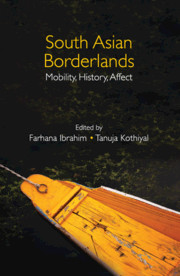Book contents
- Frontmatter
- Contents
- List of Figures and Tables
- Acknowledgements
- Introduction
- 1 Paradise at the Frontier: Kashmir as a Political Terrain and Literary Landscape in the Mughal Empire
- 2 Borders in the Age of Empire and Nation-States: The Honeycomb of Borderlands: Kumaun, Western Tibet and Far Western Nepal
- 3 Borders, Difference, Recognition: On the Cause(s) of Gorkhaland
- 4 Embattled Frontiers and Emerging Spaces: Transformation of the Tawang Border
- 5 Relative Intimacies: Belonging and Difference in Transnational Families across the Bengal Borderland
- 6 Reading Parijat in Nepal: The Poetics of Radical Feminism Negotiating Self and Nation
- 7 Commodity Journeys and Market Circuits: Making Borders ‘Natural’ in Colonial Western Himalayas
- 8 Frontiers, State and Banditry in the Thar Desert in the Nineteenth Century
- 9 Bureaucracy and Border Control: Ethnographic Perspectives on Crime, Police Reform and ‘National Security’ in Kutch, 1948–52
- 10 Frontier as Resource: Law, Crime and Sovereignty on the Margins of Empire
- About the Contributors
- Index
7 - Commodity Journeys and Market Circuits: Making Borders ‘Natural’ in Colonial Western Himalayas
Published online by Cambridge University Press: 17 September 2021
- Frontmatter
- Contents
- List of Figures and Tables
- Acknowledgements
- Introduction
- 1 Paradise at the Frontier: Kashmir as a Political Terrain and Literary Landscape in the Mughal Empire
- 2 Borders in the Age of Empire and Nation-States: The Honeycomb of Borderlands: Kumaun, Western Tibet and Far Western Nepal
- 3 Borders, Difference, Recognition: On the Cause(s) of Gorkhaland
- 4 Embattled Frontiers and Emerging Spaces: Transformation of the Tawang Border
- 5 Relative Intimacies: Belonging and Difference in Transnational Families across the Bengal Borderland
- 6 Reading Parijat in Nepal: The Poetics of Radical Feminism Negotiating Self and Nation
- 7 Commodity Journeys and Market Circuits: Making Borders ‘Natural’ in Colonial Western Himalayas
- 8 Frontiers, State and Banditry in the Thar Desert in the Nineteenth Century
- 9 Bureaucracy and Border Control: Ethnographic Perspectives on Crime, Police Reform and ‘National Security’ in Kutch, 1948–52
- 10 Frontier as Resource: Law, Crime and Sovereignty on the Margins of Empire
- About the Contributors
- Index
Summary
One important reason that the British were attracted to the western Himalayas was the prospect of trade. From the eighteenth century onwards, there were regular attempts to find out the extent of the trade that was carried out through the mountains, the countries it was carried out with and the value of this trade. Whether it was the ‘missions’ of Moorcroft and Trebeck, or of the various other explorers and merchants who were either financed by the East India Company or were helped and encouraged in their personal voyages, the question of trade dominated the agenda. Until well into the nineteenth century, the British in India assumed that the control of the Himalayas and the Hindu Kush mountains would open trade routes to them into China and Russia, respectively.
It was only in the mid-nineteenth century that it started becoming clear to the officials of the East India Company and the British government in London that the volume and value of trade, particularly through the Himalayan passes, was not worth the amount of military and financial commitment that was required to sustain it. It was only from this time that it is possible to discern a new discourse emerging in British accounts—both official as well as personal: that the Himalayas were a natural border of their Indian Empire.
Once the British realised that the scope for trade was limited over the Himalayas, much of their efforts in the nineteenth century were spent to find the ‘natural’ land borders of their Indian Empire which they could defend, most notably from the Russian Empire. Over the course of the nineteenth and twentieth centuries, these borders have been accepted as the geo-civilisational borders of India in much of popular imagination. Scholarly work too has implicitly accepted these ‘natural’ borders of British India, even if there is a recognition that the post-Partition, post-independence borders are clearly manmade; particularly in the last two decades or so with the emergence of focussed scholarship on this theme.
There has been a fair amount of work by scholars, a large number of them anthropologists, about the role of trade in sustaining Himalayan communities. Many of these works have studied in detail the nature of trade crossing borders and frontiers, the people involved and the complex networks of circulation and affect these have created.
- Type
- Chapter
- Information
- South Asian BorderlandsMobility, History, Affect, pp. 172 - 195Publisher: Cambridge University PressPrint publication year: 2021

